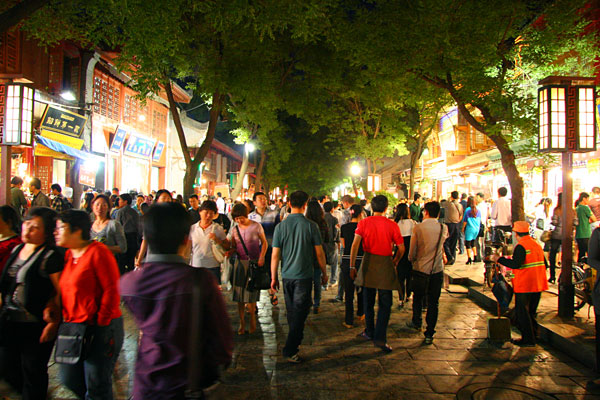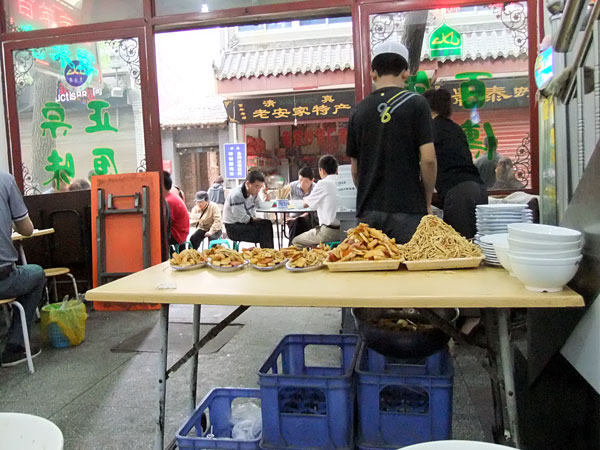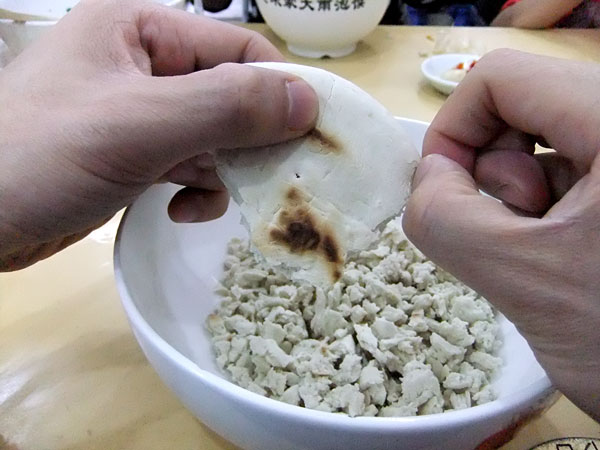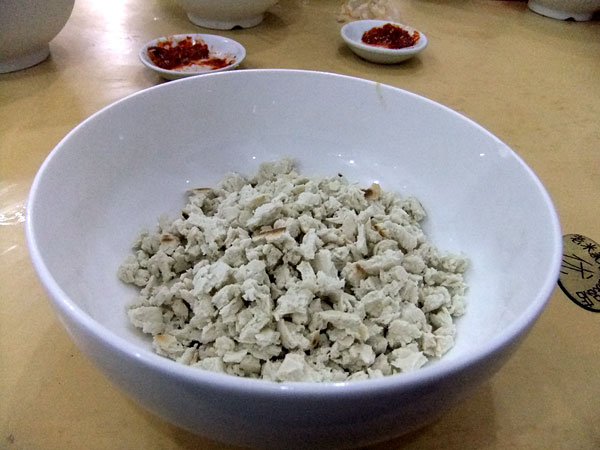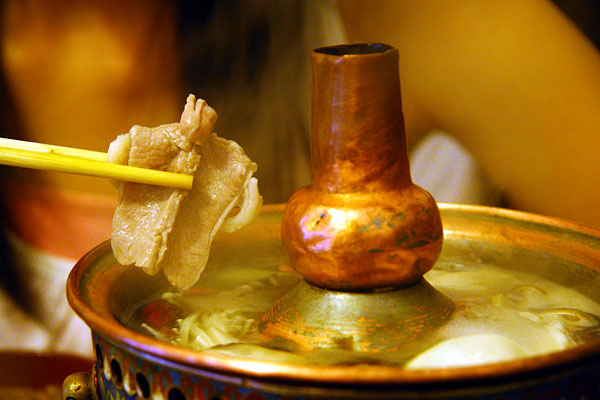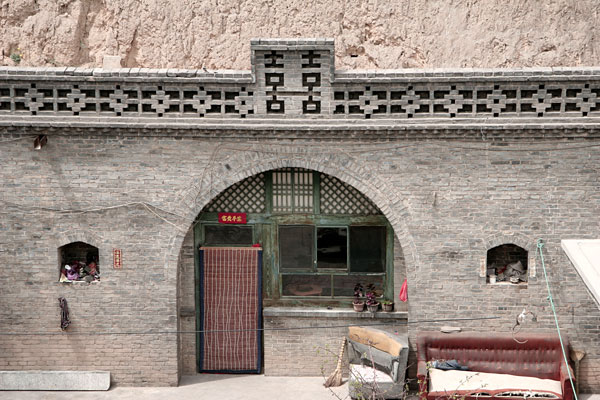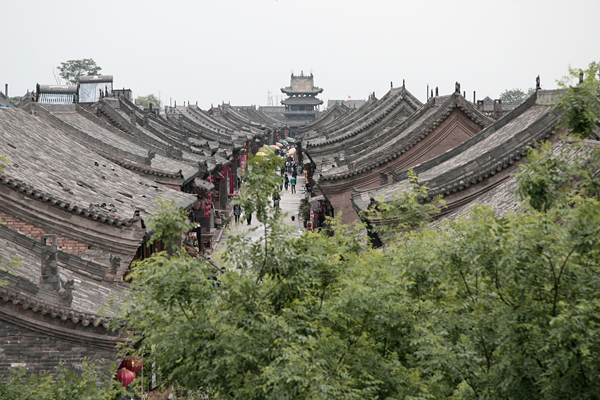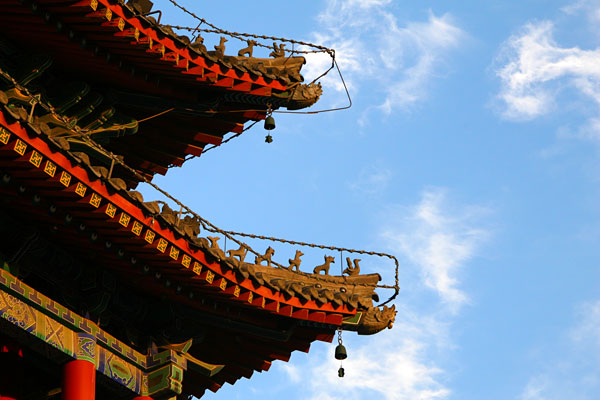
When I told my coworkers that my backpacking trip would start in Xi'an, I received mostly blank stares. But when I mentioned the Terracotta Warriors, everyone had at least some idea where I was heading.
It's unfortunate that most foreigners equate Xi'an with only the Terracotta Warriors. To the Chinese, Xi'an is synonymous with the most incredible, cheap and authentic fusion food – not from the 21st century fusion food craze, but from 1,500 years of inter-cultural mingling along the Silk Road. From here the Chinese exported their silk to the Roman Empire, and partially in return acquired Middle Eastern culinary traditions that evolved in Xi'an into a diverse repertoire of Muslim-Chinese cuisines and peasant dishes. GREAT FOOD, and not the Terracotta Warriors, was why I chose Xi'an as the start of my trip.
Here I'll continue with Part 2 of my review:
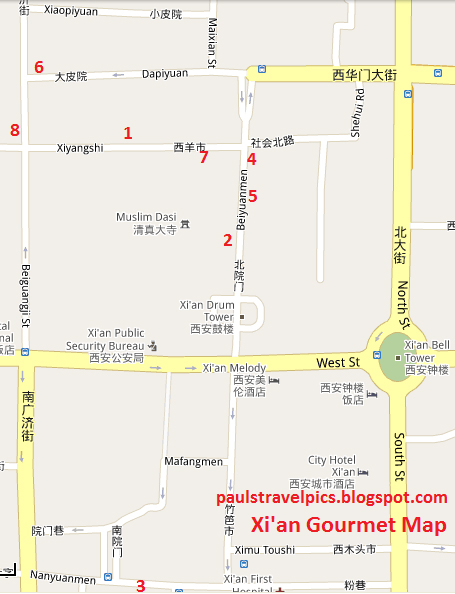
MAP LEGEND:
1.LAO MI JIA (stir-fried unleavened bread in mutton broth)
2.HONG HONG (Halal lamb skewers and fried rice)
3.BIANG BIANG MIAN (sheet noodles in specialty 3-in-1 sauce)
4.SUN JIA (meatballs and vegetables in spicy soup)
5.JIA SAN (soup dumplings and best plum juice ever)
6.SHENG ZHI WANG (cold noodles in sesame paste)
7.ZHAO JIA BAO (rose-honey flavored glutinous rice cakes)
8.QING ZHEN SHAO JI (Halal roasted free-range chicken)
2. HONG HONG -- HALAL MEAT SKEWERS AND FRIED RICE
Food Review: HONG HONG (Muslim Quarter, Xi'an)
Address: Beiyuanmen 106, Linhuqu, Xi'an
Hours: 11:00-22:00
Website/Map: From Dianping.com (in Chinese)
Directions: See location #2 on my Xi'an Gourmet Map. Start from the Drum Tower and head north on Bei Yuan Men. It's on the left hand side.
My personal favorite among all of Xi'an's gourmet offerings is the bite-sized meat skewers of the Muslim Quarter. While skewered meat is quite the ubiquitous fare at every market in Northern China, the intense competition among eateries here in the Muslim Quarter always ensures excellent tastes at reasonable prices. I'm not suggesting that you should hit any random roadside stand of questionable hygiene though -- my safe recommendation here goes to one of the most crowded eateries on the crowded Bei Yuan Men street.

Introducing Hong Hong, best known among Xi'an locals for its trademark Suan Cai Chao Mi (fried rice with pickled vegetables) and its cheap, addictive skewers. You can just smell the alluring aroma of charbroiled meat emanating in the air, even before walking through the door. Even at 21:30 on a weeknight, both of its floors were still teeming with locals and Chinese tourists alike vying for half a table. Expect to be seated on one side of a table across from a couple of locals, if you arrive in a party of two or less. Second floor of the restaurant seemed to be full of larger groups. As usual you can tell it's the right place when there are no English-speaking tour groups in sight.

My favorite skewer was only the number two best selling item on this night, according to a quick glance of our neighboring tables. EVERY TABLE STARTED WITH A FEW PLATES OF FRIED RICE, followed by skewers of each person's choice, and accompanied by cups of iced Suan Mei Tang, or plum juice. Well if that's what the locals do, it's good enough for us.

No English menu here -- just like the rest of the Muslim Quarter -- which is no surprise. Small skewers including charbroiled beef and tendon, beef tripes, tofu skin etc all cost a miniscule RMB 0.5 (CAD$ 7.5 cents) each, with a minimum order of 10 skewers. Large skewers such as lamb chunks cost RMB 1 (CAD$0.15), with a minimum order of 5 skewers. Then there are other barbecued items ranging from chicken wings (RMB 5) to a whole pomfret fish (RMB 20). Their famous fried rice, available in several different variations, cost RMB 8 a plate.

My favorite meat skewer by far is a Xi'an specialty, the perfectly tenderized, perfectly boiled, and perfectly spiced Shuan Niu Du, or flash-boiled beef tripe. It was easy to be instantly seduced by the aroma of sesame paste and chili peppers, whether you've ever had tripe or not, even before the plate landed on the table. These thinly sliced morsels came drizzled in a sesame-based sauce, and were so soft and yet chewy that I personally could have easily finished 30 skewers. Both my wife and I agreed that this was one of our favorite dishes in Xi'an.

As expected the skewers of lamb, beef and tendon were all heavily spiced with cumin and chili powder, as would be expected anywhere in Northern China. Interestingly both the beef and the lamb smelled of lamb, possibly as a result of the preparation process, and we could hardly taste the difference. My wife also ordered two skewers of chicken gizzard. Not bad, but nowhere as spectacular as the flash-boiled beef tripe.

This is the one dish that every table have come to order, the Suan Cai Chao Mi that prominently features in the full name of the restaurant, Hong Hong Suan Cai Chao Mi. I must admit that I did not expect to see fried rice this far north in China, deep in the noodle country of Shaanxi Province. But the fried rice did turn out quite good, boldly seasoned with cumin and chili oil, mildly spicy green peppers, diced onions, beef and of course, Suan Cai (pickles). The rice was a little oily if I were to nitpick, but that was really not a problem since everyone washed down the fried rice with a cup of iced Suan Mei Tang (plum juice) to quench the spiciness and cleanse the palate in the process.

Greasy, spicy and mouthwatering, this place had everything that a night-market fried rice stand was supposed to taste like, delivered in a family-run eatery setting in the Muslim Quarter's busiest section. Though next time I would probably skip the charbroiled lamb and simply order 30 skewers of beef tripe to go with the fried rice. As for the plum juice? I would just walk a little further down the street and get the amazing hawthorn-and-plum juice from the century-old local favorite of Jia San.
Bill for Two Persons
| Beef Tripe Skewers x 10 | RMB 5 |
| Lamb Skewers x 5 | RMB 5 |
| Beef and Tendon Skewers x 10 | RMB 5 |
| Chicken Gizzard Skewers x 2 | RMB 4 |
| Suan Cai Chao Mi (Fried Rice with Pickled Vegetables) | RMB 8 |
| Plum Juice x 2 | RMB 4 |
| TOTAL | RMB 31 (CAD$4.7) |
3. BIANG BIANG MIAN -- XI'AN'S OWN UNIQUE NOODLES
Food Review: BIANG BIANG MIAN (aka Noodle King) (Xi'an)
Address: Nanyuanmen 80, Beilinqu, Xi'an
Hours: Unknown, but approx 10:00-20:00 according to my observation
Website/Map: From Dianping.com (in Chinese)
Directions: See location #3 on my Xi'an Gourmet Map. It's a 15 minutes walking distance south of the Muslim Quarter.
While fried rice remains somewhat of a delicacy to the masses of Xi'an, handmade, homey noodles remain the main staple food of common folks. But if your idea of noodles consists of long threads (or ribbons) of flour common all over East Asia ... well you need to visit Xi'an.

Xi'an's contribution to the world of noodles/pasta is its signature, extremely wide and long ribbons known generically as Ku Dai Mian (belt noodles), or as the commercially trademarked Biang Biang Mian. Nobody seems to have a clear explanation what Biang Biang means, though some say it's the sound of your teeth bouncing off the "al dente" texture of the noodles. There are several Biang Biang Mian outlets in town, and the one I visited is marked #3 on my Xi'an Gourmet Map, on Nan Yuan Men street near the centre of the city.
It's a small shop with 8 or so tables and walls covered with pictures and signatures of various local celebrities. There were no English menus though, which on the other hand also meant very cheap prices. Noodles were generally in the range of RMB 8-10 depending on size, and side dishes of marinated vegetables were RMB 10 each. Only one type of noodles was served, not surprisingly, though there were several flavors to choose from: Saozi (spicy minced pork), Zhajiang (meat gravy), Tomato and Eggs, or San He Yi (3-in-1) which was the combination of the above three.
Everyone ordered at the front counter then found a table at the back. As the shop was still busy at 15:00 in the afternoon, some random local dude walked in and sat at my table, ordering a bowl of 3-in-1 and a bottle of local beer served in a bowl.

The spiciness of hot chili peppers filled the air as my own bowl of 3-in-1 arrived. One can actually pick out the three flavors in the picture -- meat gravy from the 4 o'clock position of the bowl to 9 o'clock, spicy minced pork from 9 o'clock to 12 o'clock, tomato and eggs from 12 o'clock to 4 o'clock, and topped with a wallop of green onions, dried hot peppers and chili oil. The noodles were, just as the legends say, extremely wide, smooth and chewy. Imagine cutting very long strips of al-dente-boiled lasagne lengthwise, serving in a rich gravy sauce with minced pork and tomatoes ... wait that almost sounds Italianesque!
Although I should have asked for Wei La, or mildly spicy, the combination of gravy and minced pork was quite delicious and the noodles were wonderfully chewy. A mere RMB 8 (CAD$1.2) for a tasty, authentically Xi'an meal in the city centre, this was quite a bargain even by Chinese standards. I spent more on a bottle of yogurt at the supermarket after the meal ... go figure.
Bill for One Person
| San He Yi (3-in-1) Noodles (small) | RMB 8 |
| TOTAL | RMB 8 (CAD$1.2) |
4. SUN JIA -- 100-YEAR-OLD SPICY SOUP WITH HALAL MEATBALLS
Food Review: SUN JIA ROU WAN HU LA TANG (Muslim Quarter, Xi'an)
Address: North end of Beiyuanmen, Lianhuqu, Xi'an
Hours: 6am until Sold Out
Website/Map: From Dianping.com (in Chinese)
Directions: See location #4 on my Xi'an Gourmet Map. Start from the Drum Tower and head north on Bei Yuan Men. It's on the right hand side towards the end, across from the entrance to Xiyangshi street.

Beijingers love their deep-fried dough and roasted meat sandwiches for breakfast, and the people of Hong Kong crave their rice porridge and macaroni in soup. As for Xi'an, one of the most popular and cheap breakfast fares is a simple bowl of Halal beef meatballs in a thick, extremely spicy soup known as Rou Wan Hu La Tang.
Take an early morning walk in the Muslim Quarter and let your nose follow a certain distinctive pungent spiciness. Chances are you'll come across one of many little shops with a large metal pot out front, and a middle-aged guy yelling "Hu La Tang!" This particular morning we sat down at the 100-plus-year-old Sun Jia on Bei Yuan Men street.

We followed the stream of locals to the big pot/barrel outside the shop and ordered two bowls of soup and one slice of bread -- after all that's all they sold for the past hundred years. The ingredient here seemed to be quite a mishmash of grape-sized beef meatballs, Chinese cabbages, potato cubes, carrots and zucchini.

But warned that this Hu La Tang was the spiciest of all things we tasted in Xi'an, a city well-known for its love of chili peppers. The key here is not the spiciness of the chili oil, but the numbing effects of a serious dose of Sichuan peppers. In fact not only my tongue, but my whole mouth was in a state of tingly, pins-and-needles numbness the whole time, which should sound familiar to fans of Sichuan cuisine. If you're a lover of all things spicy and hot, this breakfast is for you.
Bill for Two Persons
| Hu La Tang (Meatballs in Spicy Soup) | RMB 3.5 |
| Hu La Tang (Meatballs in Spicy Soup) | RMB 3.5 |
| Tuo Tuo Mo (Roasted Bread) | RMB 0.5 |
| TOTAL | RMB 7.5 (CAD$1.1) |

